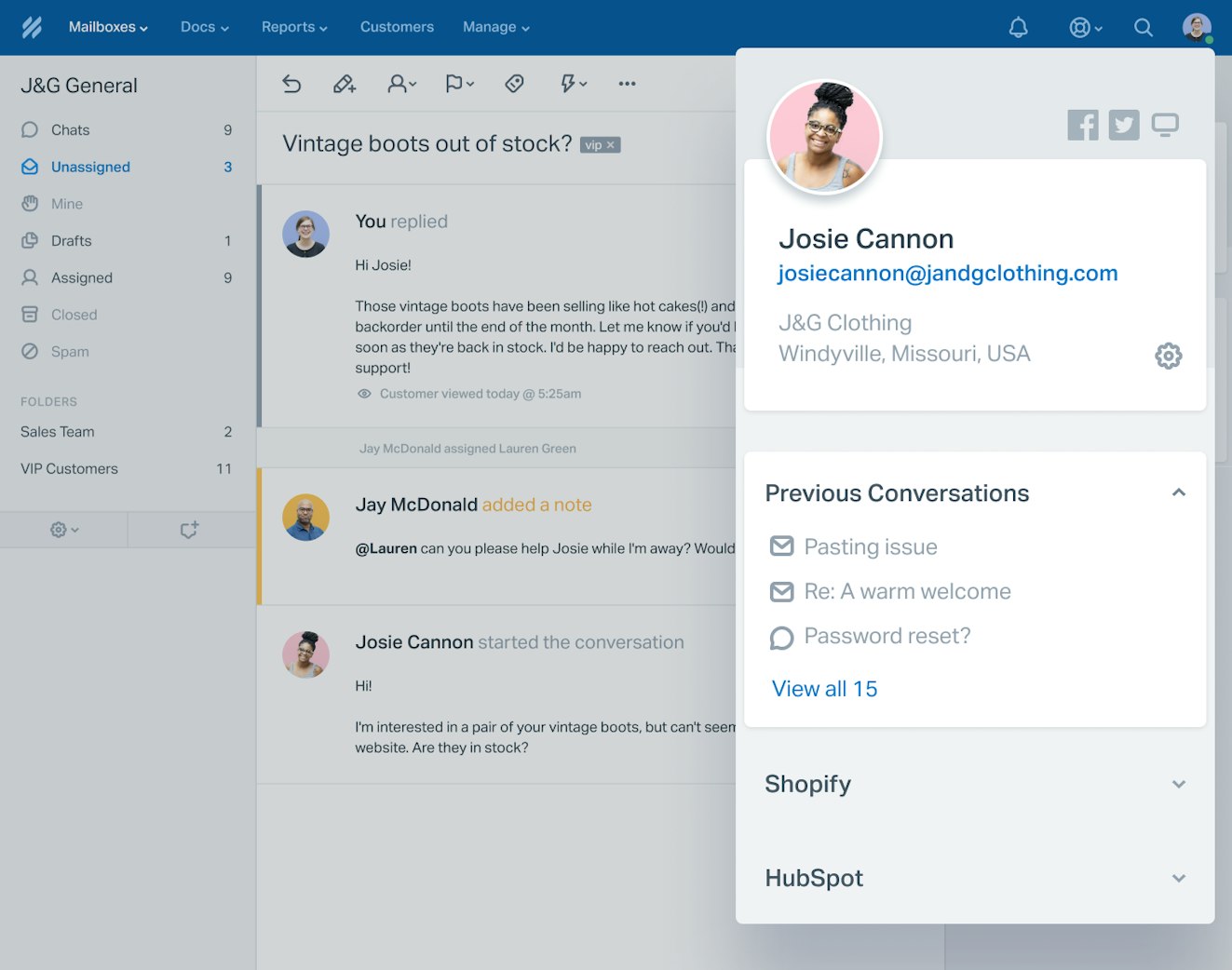At this point, most people have heard of omnichannel customer service. While it is no longer the ever-present buzzword in every support blog post and newsletter that it used to be, many companies are still curious about how omnichannel customer service can benefit them.
In this post, we’ll break down what omnichannel customer service is, its key benefits, how to get started building an omnichannel customer service strategy, and best practices around doing it well.
What is omnichannel customer service?
Omnichannel customer service is a strategy that involves providing customer support across many different channels and touchpoints. This differentiates it from traditional support where teams focus primarily on a single channel, like phone, email, or chat support.
However, omnichannel support is more than just providing support across multiple channels. The goal of omnichannel support is to develop a synchronized customer service model so that all communication channels are aligned and functioning simultaneously.
In an omnichannel support approach, support requests from multiple channels flow into a single track, providing context for your support agents and an excellent customer experience.
Omnichannel vs. multichannel customer service
The critical point that differentiates omnichannel from multichannel support is that omnichannel offers a seamless experience, regardless of where the customer begins the interaction.
Multichannel customer service is simply the act of providing customer support across multiple channels. Instead of just offering email, you might also provide social media or chat support.
Similarly, an omnichannel customer service strategy features support across multiple channels. The critical difference is that your customers can switch to another channel mid-conversation. With multichannel, that’s not an option.
As you might expect, multichannel and omnichannel customer service provide different experiences for customers.
In multichannel, the focus is less customer-centric and more customer-appeasing, which means that rather than delivering a genuinely cohesive experience, multichannel is simply trying to start the conversation off on the right foot.
Omnichannel prioritizes consistency across all channels, rather than just an excellent first-touch experience.
For instance, with omnichannel support, a customer could look at a site on their phone and decide to start a conversation through live chat. But they’re on their train commute to work, and when their train goes underground, they lose connection to chat.
As soon as they are above ground, they can call in to continue their conversation, and the customer support agent picks up right where they left off.
With multichannel support, that same customer would need to explain the context for their conversation to the customer support agent answering the phone. The context would be lost, and the experience would be significantly less delightful.
While the customer can talk to your customer support team on whichever channel they’d like, there’s no linking or consistency across them.
The key benefits of omnichannel customer service
As you can probably guess, there are many benefits of omnichannel customer service. Whether they are for your customers, your employees, or even your company, here’s a list of the top benefits of offering omnichannel customer service.
Improve customer satisfaction
Companies that have spent time implementing an omnichannel customer service strategy typically have better retention and satisfaction than those that haven’t put as much intent into their service plans.
Recent studies show that 63% of customers love brands because of their excellent service rather than the product itself.
When you have an omnichannel customer service strategy that feels seamless, you’ll likely see improved customer satisfaction along with it.
Engage more varied groups of customers
When you provide more options for people to reach out to you, you are primed to get many more customers engaging with you. People who might not have wanted to talk to support over the phone may feel more inclined to reach out if you have mobile or text options — or if they can switch channels on the go.
When you implement omnichannel customer service software, it creates additional availability. You can use that availability to gain deeper insights across the span of your customer base beyond the primary groups that you regularly serve.
For instance, perhaps with easier availability, you find the scope of customer service extending beyond your already paying customers into potential customers or prospects. All this data can feed back into your customer service strategy to help you improve your processes even more as you grow.
Gain additional context
Along with reaching new and varied customers with your omnichannel customer service strategy, you’ll also be empowering your customer service team to help those customers more readily.
One of the critical components of a robust omnichannel strategy is integration. Each of your channels should be directly tied together so that information can readily flow.
If you’ve implemented your omnichannel software properly, your customer service team should have a ton of information at their fingertips from the very beginning of the conversation.

With that data, you can empower your customer service team to make even better decisions when it comes to helping customers. A team member empowered with data about conversation history will be better equipped to help a customer than someone going in without any visibility.
This level of context also helps to promote the “seamlessness” of the experience. Your customers never have to explain themselves twice, and they’ll get a faster and more complete response from a customer service agent who doesn’t need to dig for extra information.
Get better data
You have a much better leg to stand on when making metrics-driven decisions about your customer service strategy with all of this recorded customer data. You’ll have a broader scope of information about how your customers interact with your brand and how their needs might differ across channels.
Your team might have data around how your customers interact over chat or email in a traditional support structure. With an omnichannel service structure, you can see how your customers’ needs differ as they travel through channels or how the same condition changes throughout an interaction.
You’ll be able to tweak your ongoing support strategy better, even outside of omnichannel, because you’ll be able to understand your customer lifecycle and deliver better, more personalized support through that knowledge.
How to create an omnichannel customer service strategy
Now that you understand the more profound benefits of an omnichannel customer service strategy, you are probably eager to get started building your own. Here are the first steps to take.
Understand what your customers are looking for
Just because omnichannel can support tons of channels linked together doesn’t mean that it should. When creating an omnichannel customer service strategy, the first step is to understand what your customers are currently using and what they’re interested in.
Depending on their demographic, some customers may be more inclined to use specific channels over others. For instance, in 2019 Instagram was the most-used platform for Gen Z (73%), while Facebook remained the top choice for millennials, Gen X, and boomers.
Instead of crafting an omnichannel strategy that covers all the bases, try to be strategic. Identify the channels that your customers use or ask for the most, and incorporate those into your planning. It’s better to be excellent at just a few channels than to be mediocre in your abundance.
Focus on mobile accessibility
One of the reasons customers love omnichannel customer service is that they can easily switch contexts and have their conversations remain accessible. That means they can start a conversation on their phone and finish it on their computer, their tablet, or another device.
If your omnichannel strategy doesn’t support every channel from a mobile perspective, it isn’t strong enough. Customers want to do everything from their phones that they can do on their computers — 79% of smartphone users have made a purchase using just their smartphone in the last six months.
If you offer email, chat, and phone support, customers should engage all of those on their mobile phones with the same level of ease that they could on a computer.
Map your customer journey
A recent study revealed 54% of implementers believe the most significant inhibitor in establishing a consistent omnichannel experience is not having a single view of customers across all of their channels.
If you set out on a journey without a map, it will take you longer to get where you’re going, and you may not even end up where you intended to go. When creating any strategy, but especially one for omnichannel customer service, ensure that you have mapped out what the journey currently looks like first.
When you’ve mapped out your current customer journey, you can identify bottlenecks or issues that you can try to resolve or improve with your omnichannel support strategy. It can also help improve your current omnichannel strategy if you aren’t just getting started building one from scratch.
Recognizing the traditional paths your customers usually take, including the channels they use most frequently, will help you understand where to focus your resources during strategy building.
Segment your audience
No two people on this planet are alike — so why would you treat all of your customers like they have the same needs and expectations?
Instead of bundling all of your customers into a single group, consider segmenting them. Not only will it make supporting your customers more manageable, but it will also allow you to cater to the experiences that you provide each user.
Some companies choose to segment based on the amount of money that a customer is spending with them. For instance, someone on your enterprise tier for pricing would be segmented away from your trial or freemium users.
Other companies choose to segment based on the type of products that customers have purchased, how long they have been a customer, physical location, or customer demographics.
Segmenting and differentiating your omnichannel customer service experience is a great way to give your team the space to focus on providing the right level of service to every customer.
For instance, an enterprise customer likely expects a more immediate and in-depth experience than someone on your free or trial product. Healthy prioritization among segments makes for a better experience for customers and employees.
Always be learning
Last, but certainly not least, is to continually learn from your mistakes. Part of the beauty of working on a digital strategy is that you can change it quickly if needed. If something in your plan isn’t working or you notice that your customers’ sentiment is dropping, pull your data and evaluate what you could change.
With an omnichannel strategy, there should be a track record of everything that your customers are experiencing. Use that boosted data to get deeper insights to improve your customer experience in the long run. Iterate on your process using those insights, and your omnichannel experience will get better and better.
Omnichannel customer service best practices
After implementing an omnichannel customer service strategy and honing it to get to the best possible processes, you can develop your own best practices even more. Hold these omnichannel customer service best practices in mind as you move forward to create an even more solid strategy.
Create a centralized place for your data
As you know, the main difference between omnichannel and multichannel customer service is that omnichannel is all interconnected. The easiest way to do this is to use software specifically designed to help offer omnichannel functionality.
Equally important is the data flow. It is necessary to create a centralized place for your data to collect every piece of information about a customer from the different areas of the business. That includes:
What they’ve viewed on your website.
Any conversations they’ve had with your sales team.
Comments they’ve left on your blog.
Interactions they have had with your support team
Any other relevant demographic data.
Not only will this help your marketing team create better outreach, but it will also help your support team maintain consistent messaging and context whenever your customers might reach out. Some companies even use this data to automate proactive outreach.
For instance, you could trigger a proactive message with a link to your documentation after users navigate to a specific area of your website or product.
Keep things convenient
As soon as things become complex or frustrating for your customers, you lose the delight and goodwill you’ve built by offering omnichannel customer service.
Whenever you consider adding or changing something about your omnichannel strategy, first identify if it will complicate or simplify your current processes. If it makes the experience any less convenient, are there additional benefits that outweigh the detractions?
The main driver of omnichannel customer service is the convenience and ease it provides for the customer and your customer service team. Be aware of the cost of shifting toward anything that may create more strife rather than moving toward a more smooth, convenient experience.
Be consistent
Along with convenience, consistency is essential with your omnichannel customer service strategy. After all, consistency across your different channels is one of the primary drivers for customers enjoying omnichannel over other types of customer service.
Work to create consistency across all of your channels, including in capabilities, brand, tone, and style. If you notice yourself making changes to one medium but not to the others, identify why.
If you can’t do a refund over chat, for instance, but you can do it over phone or email, it may be time to find a way to make that accessible for your team.
You should be able to do anything that you can do via one channel in all of the others. Otherwise, you may confuse your customers and leave your agents in a sticky spot if they need to explain different policies to an upset customer.
Start small
Once you’ve dipped your toe in the water, it can feel so tempting to dive right in. But, as with most strategy changes, start with minor modifications. Small shifts in strategy allow you to see how they affect your customers’ experiences without causing significant disruptions to your service.
If you’re just starting with your strategy, that means picking just a few channels and focusing on moving a specific metric over time. Use this period to identify which channels are most well-received by your customers, and determine which qualities are the most impactful.
For instance, if you discover that your customers love the speed of chat, see how you might be able to bring that same speed to your other channels.
Not everything outside of the original implementation of your omnichannel customer service strategy needs to be a huge overhaul. More minor changes leave room for experimentation and are much less disruptive to your customers.
Build your omnichannel support strategy from the ground up
Whether you’re just starting to conceptualize how omnichannel looks for your company or you’re already making improvements, remember to start small.
Start by figuring out the essential ground-level features for your customers:
Which channels do they care about most?
Which features of those channels are most important?
How do they define convenience?
In what ways are you building consistency?
These key components will help you move forward with a strategy that feels good both for your customers and your team.
Beyond figuring out the bare necessities, play around with what omnichannel means for you. Do you use a single tool to offer omnichannel customer service, or do you just make heavy use of integrations? Does your methodology require any additional tools that you will need to purchase or evaluate?
Omnichannel customer service is an excellent option for both your customers and your team, but you don’t need to dive in entirely right away. Start slowly and with purposeful consideration, and you’ll have an excellent, functional process in no time.












